Introduction

SanDisk's Extreme II series is their Enthusiast Class SSD. SanDisk designed the Extreme II to take on all comers performance wise as well as provide unmatched endurance capabilities by lowering write amplification. SanDisk utilizes the finest components in the Extreme II. While other manufacturers are trending toward inferior TLC (Triple Level Cell or 3-bit-per-cell) NAND implementation, SanDisk is utilizing premium MLC (Multi Level Cell or 2-bit-per-cell) 19nm DDR NAND Flash to power the Extreme II. This is not just some ordinary 19nm flash; this flash has an emulated SLC (Single Level Cell) layer baked right in. SanDisk calls this emulated SLC technology "nCache".
So, what is SLC emulation and why does it matter? 1-bit-per-cell NAND (SLC) is the "good stuff" because it has vastly superior performance and longevity in comparison to (MLC) 2-bit-per-cell or (TLC) 3-bit-per-cell NAND technology. Programming a single bit-per-cell can be accomplished at a much lower latency than programming multiple bits-per-cell, and is the reason SLC NAND provides superior performance. SLC NAND is typically rated for 100K P/E (Program/Erase) cycles whereas MLC/TLC NAND is rated for 0.5K to 5K P/E cycles. The drawback to SLC NAND implementation is cost. SLC NAND is in order of magnitude more expensive to fabricate than MLC or TLC NAND. SanDisk came up with a brilliant technology called "nCache".
nCache Technology allows a layer of an MLC NAND array to be programmed as single bit-per-cell. This pseudo SLC layer has lower latency and greater endurance than the rest of the MLC NAND array. nCache Technology is used to accumulate small writes (called segments) at high speed and then flush and consolidate them to the larger MLC section of the NAND Flash memory array, thereby greatly reducing write amplification. Reducing write amplification is the key to an MLC based drive's longevity, reliability, and long term performance.
The Extreme II has at its heart Marvell's third generation 88SS8197 Flash Storage Processor. Dubbed "Monet," this processor is capable of 200 MB/s per channel internally as well as unparalleled correction capabilities due to its high performance ECC engine with Adaptive Read and Write Scheme, on-chip RAID functionality, and open architecture. An open architecture will allow SSD manufacturers to fully customize their products to meet specific customer demands and distinguish their products based on price, performance, power and functionality. Open architecture also allows SanDisk to fully customize firmware to their own specifications and even introduce innovations like "nCache".
Today we've got two and three drive Extreme II array's running balls out in RAID 0 for your viewing pleasure. Let's see how SanDisk's current Enthusiast series drives perform in RAID 0 powered by Intel Haswell ports and Microsoft Windows 8.1.
Specifications, Pricing and Availability

The SanDisk Extreme II is available in three capacity sizes, 120GB, 240GB, and 480GB. Specifications list the 240GB Extreme II SSD as capable of up to 550 MB/s sequential reads and up to 510 MB/s sequential writes. Random read/write speed is listed at up to 95,000/78,000 IOPS at 4K QD32. The Extreme II has a 7mm z-height, allowing for more compatibility with newer laptops.
SanDisk backs their Extreme II series SSD's with an industry leading five year warranty. The 240GB Extreme II is currently available from Amazon for $180 (75 cents per GB). Since this is a RAID review, we are going to focus on performance rather than features.
For a more in-depth look at the SanDisk Extreme II's feature set, I will refer you to Chris Ramseyer's extensive review of the SanDisk Extreme II 240GB SSD.
SanDisk Extreme II 240GB SSD
Our drives arrived bare so we don't have any retail packaging to show you.

The top of the enclosure is formed from a single piece of black plastic. Centered on the top face of the drive is a black manufacturer's sticker with red and white lettering.

The bottom and sides of the enclosure are formed from a single piece of stamped aluminum painted black. Centered on the rear face of the enclosure is a manufacturer's sticker that lists the drives part number, serial number, capacity, and interface.

Here's what the SanDisk Extreme II 240GB SSD looks like completely disassembled. The Extreme II has a full sized PCB. The drives controller, DRAM module, and NAND chips all make contact with a thermal pad; thereby dissipating heat generated into the aluminum half of the enclosure. The other side of the PCB is devoid of any major components.
Benchmarks - Test System Setup, Drive Properties & ATTO Baseline Performance
Desktop Test System

Drive Properties

The majority of our testing will be done with our test drive/array as our boot volume. Our boot volume is 75% full for all OS Disk "C" drive testing, to mimic a typical consumer OS volume implementation. We're using 64K stripes for all our arrays. Write caching is enabled.
All of our testing includes charting the performance of a single test subject as well as a RAID 0 array of our test subject. In this particular review we will be charting the performance of both a two and three drive array. We will be posting screen shots of our three drive arrays benchmarks.
ATTO Baseline Performance
Version and / or Patch Used: 2.47
ATTO is a timeless benchmark used to provide manufactures with data used for marketing storage products.

Slightly choppy performance from our two drive array but, smooth as butter performance from our three drive array.
Sequential Write

We fill our array with random 4K data and run ATTO almost immediately after. This choppy performance tends to smooth out over time after the array has had time to recover from being filled to 75% of its total capacity. Before we ran the three drive array, we waited ten minutes, and as you can see this smoothed out our arrays performance. Our three drive array easily smokes the rest of the pack.
Sequential Read

When it comes to read transfers, the Extreme II's performance is as good as it gets. Both our two drive and three drive Extreme II arrays outperform the rest of the arrays on our chart.
Benchmarks - Anvil Storage Utilities
Anvil Storage Utilities
Version and / or Patch Used: RC6
So what is Anvil Storage Utilities? First of all, it is a storage benchmark for SSD's and HDD's where you can check and monitor your performance. The Standard Storage Benchmark performs a series of tests; you can run a full test, or just the read or the write test, or you can run a single test, i.e. 4K QD16.
The software is used several different ways and to show different aspects for each drive. We've chosen to use this software to show the performance of a drive with two different data sets. The first is with compressible data and the second data set is incompressible data. Several users have requested this data in our SSD reviews.
0-Fill Compressible Data

An Anvil score of 11,000 clearly shows why we consider the SanDisk Extreme II one of a handful of "Hyper-Class" SSD's.
0-Fill Compressible Read IOPS through Queue Depth Scale
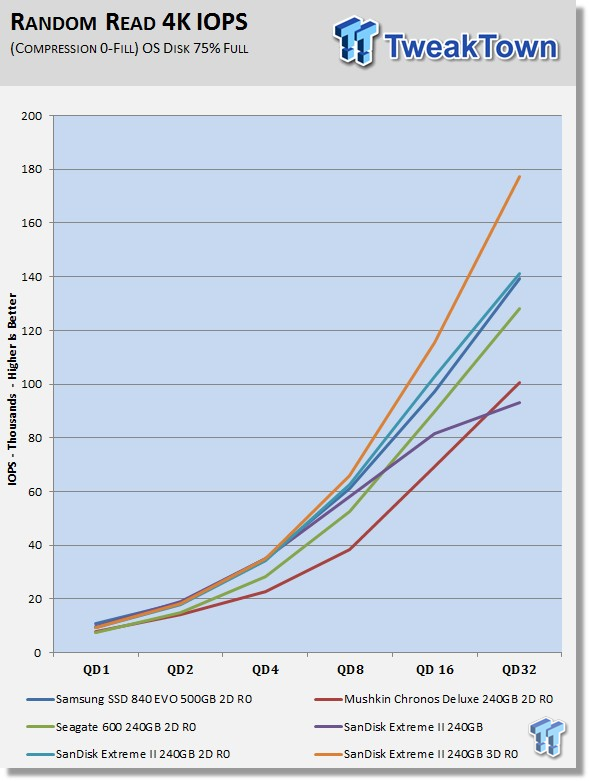
Mirroring our ATTO read results, we find the Extreme II outperforming the other arrays on our chart as commands stack up.
0-Fill Compressible Write IOPS through Queue Depth Scale
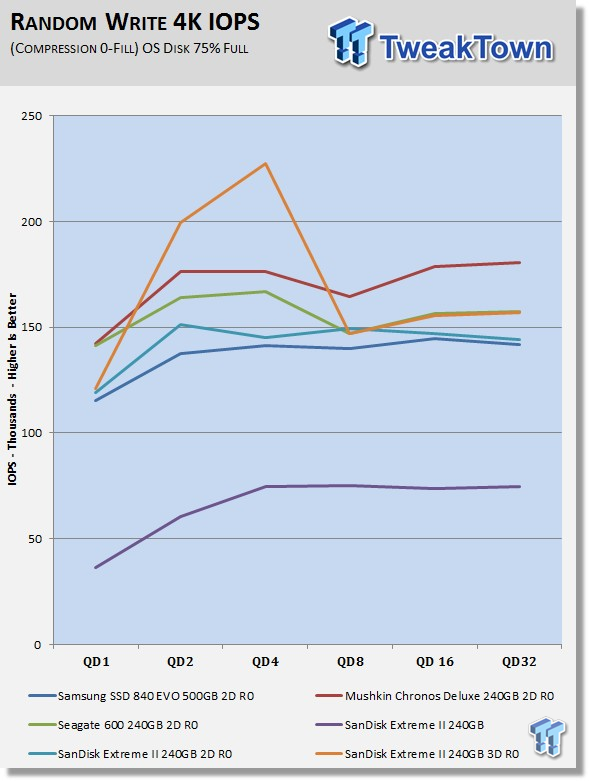
Write caching enables our array to put out nearly three times the performance of a single drive at 4K QD1. SanDisk designed the Extreme II to provide superior write performance at low queue levels, peaking at 4K QD2 - 4K QD4. We like this approach because the vast majority of commands are executed in this range.
Compression 100% Incompressible Data

Overall, the Extreme II is slightly faster when digesting compressible data.
Incompressible Read IOPS through Queue Depth Scale
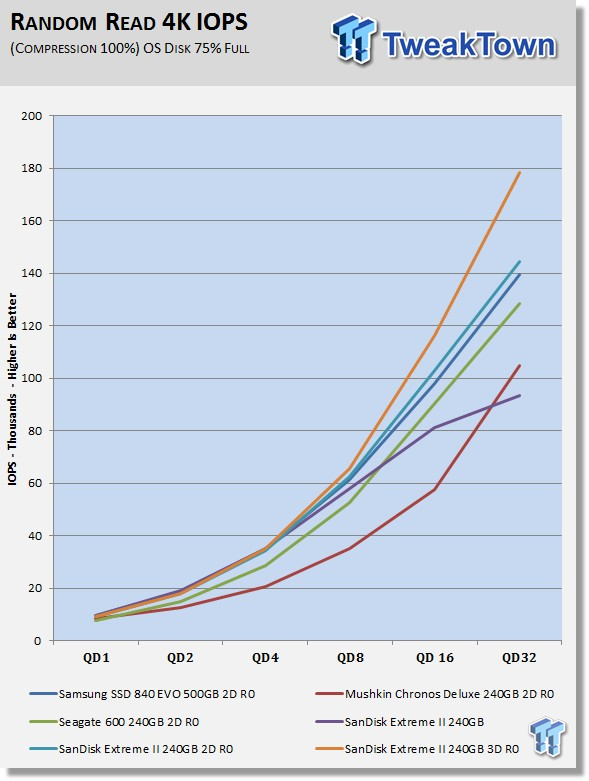
Both our Extreme II arrays are faster than the other arrays on our chart when reading data, especially as commands stack up.
Incompressible Write IOPS through Queue Scale

Writing incompressible data does change the Extreme II's performance significantly in comparison to writing compressible data. If you want to split hairs, the Extreme II two drive array comes in just behind the EVO and 600 two drive arrays. As we would expect to see, our three drive array blows away the two drive arrays at QD2 - QD4.
Benchmarks - CrystalDiskMark
CrystalDiskMark
Version and / or Patch Used: 3.0 Technical Preview
Developer Homepage: http://crystalmark.info
Product Homepage: http://crystalmark.info/software/CrystalDiskMark/index-e.hl
Download here: http://crystaldew.info/category/software/crystaldiskmark
CrystalDiskMark is disk benchmark software that allows us to benchmark 4K and 4K queue depths with accuracy.
Note: Crystal Disk Mark 3.0 Technical Preview was used for these tests since it offers the ability to measure native command queuing at 4 and 32.

Sequentially, three drives pretty much max out a Haswell chipset.

Once again we see that both of our Extreme II arrays are faster than all the other arrays on our chart when reading sequentially.

As write commands stack up, a three drive array has a definitive advantage over a two drive array. Our two drive Extreme II array comes in second place to our EVO array.
Benchmarks - AS SSD
AS SSD
Version and / or Patch Used: 1.7.4739.38088
Product Homepage: http://alex-is.de/PHP/fusion/news.php
Download here: http://alex-is.de/PHP/fusion/downloads.php
AS SSD determines the performance of Solid State Drives (SSD). The tool contains four synthetic as well as three practice tests. The synthetic tests are to determine the sequential and random read and write performance of the SSD. These tests are carried out without the use of the operating system caches.

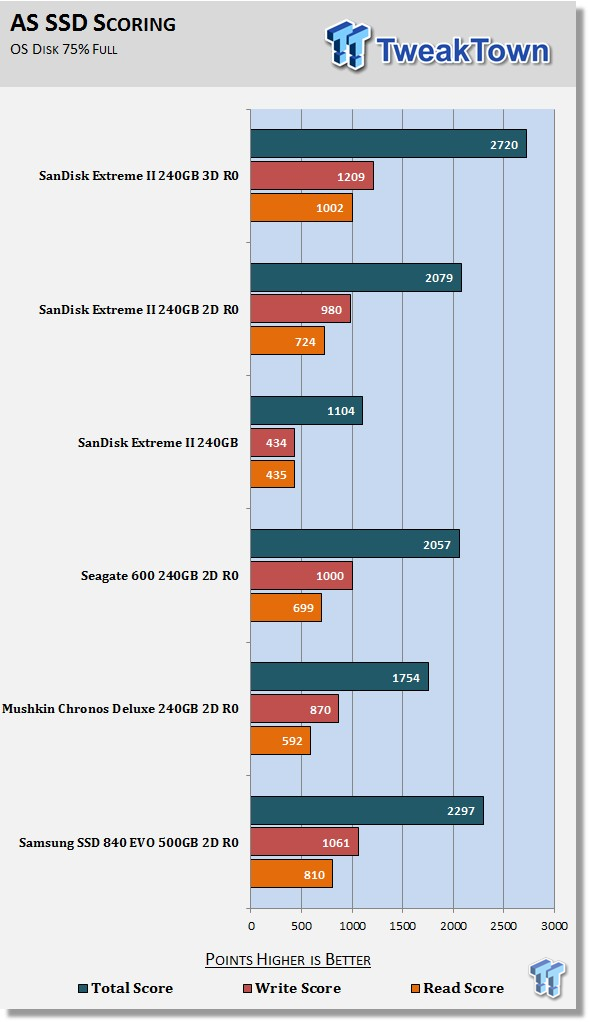
Our two drive Extreme II array is able to nearly double the score of a single drive, and as we would expect to see, our three drive array leaves everything else in the dust.
Benchmarks - PCMark Vantage
PCMark Vantage - Hard Disk Tests
Version and / or Patch Used: 1.2.0.0
Developer Homepage: http://www.futuremark.com
Product Homepage: http://www.futuremark.com/products/pcmarkvantage

PCMark Vantage is the first objective hardware performance benchmark for PCs running 32 and 64-bit versions of Microsoft Windows Vista. PCMark Vantage is perfectly suited for benchmarking any type of Microsoft Windows Vista PC from multimedia home entertainment systems and laptops to dedicated workstations and high-end gaming rigs. Regardless of whether the benchmarker is an artist or an IT Professional, PCMark Vantage shows the user where their system soars or falls flat, and how to get the most performance possible out of their hardware. PCMark Vantage is easy enough for even the most casual enthusiast to use yet supports in-depth, professional industry grade testing.
The reason we like PCMark Vantage is because the recorded traces are played back without system stops. What we see is the raw performance of the drive. This allows us to see a marked difference between scoring that other trace based benchmarks do not exhibit. An example of a marked difference in scoring on the same drive would be empty vs. filled vs. steady state.
We run Vantage three ways. The first run is with the OS drive/Array 75% full to simulate a lightly used OS volume filled with data to an amount we feel is common for most users. The second run is with the OS volume written into a "Steady State" utilizing SNIA's guidelines (Rev 1.1). Steady state testing simulates a drive/arrays performance similar to that of a drive/array that has been subjected to consumer workloads for extensive amounts of time. The third run is a Vantage HDD test with the test drive/array attached as an empty lightly used secondary device.
OS Volume 75% full - Lightly Used

OS Volume 75% full - Steady State

Secondary Volume Empty - Lightly Used
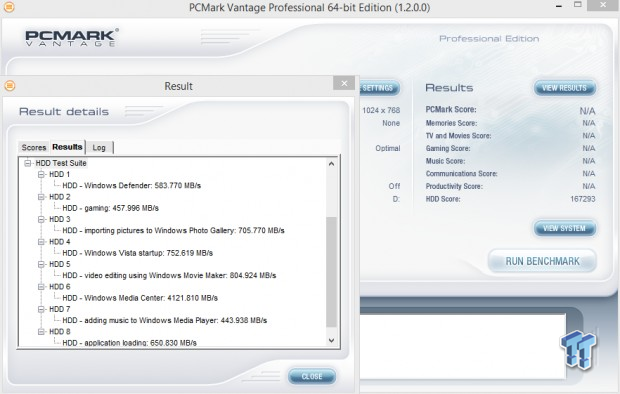
As you can see, there's a big difference between an empty drive/array, one that's 75% full/used, and one that's in a steady state.

The important scores to pay attention to are "OS Volume Steady State" and "OS Volume 75% full". These two categories are most important because they are indicative of typical consumer based user states.
When a drive/array is in a steady state, it means garbage collection is running at the same time it's reading/writing. There is a huge difference in performance between a single drive and a two drive array. The difference between a two and three drive array isn't that huge, but it's still significant.
Benchmarks - PCMark 7
PCMark 7 - System Storage
Version and / or Patch Used: 1.4.00
Developer Homepage: http://www.futuremark.com
Product Homepage: http://www.futuremark.com/benchmarks/pcmark7
PCMark 7 includes 7 PC tests for Windows 7 & 8, combining more than 25 individual workloads covering storage, computation, image and video manipulation, web browsing, and gaming. Specifically designed to cover the full range of PC hardware from netbooks and tablets to notebooks and desktops, PCMark 7 offers complete PC performance testing for Windows 7 & 8 for home and business use.
We will look to the Raw system storage scoring for RAID 0 evaluations because it's done without system stops, and therefore allows us to see significant scoring differences between drives/arrays.
OS Volume 75% full - Lightly Used

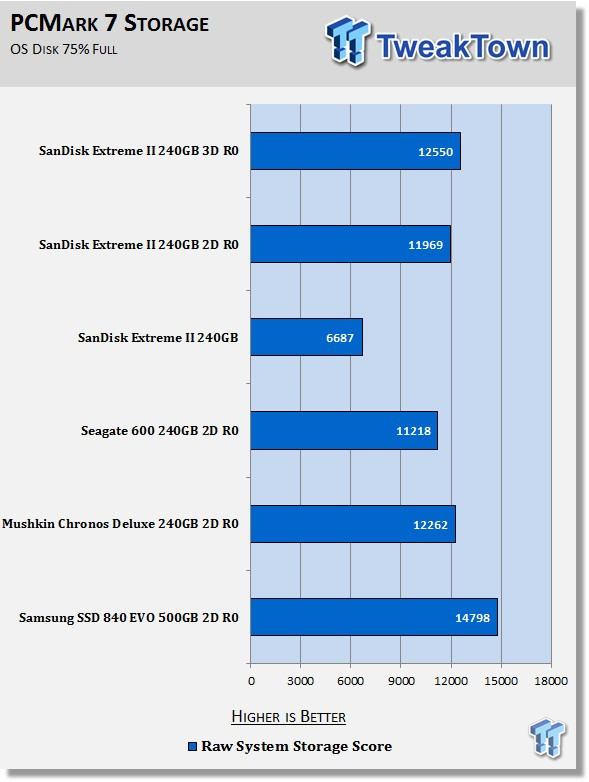
Just as we saw with our Vantage testing, there is a huge difference between a single drive and a two drive array, and not much difference between a two drive and three drive array.
Benchmarks - PCMark 8
PCMark 8 - Storage Bandwidth
Version and / or Patch Used: 1.2.157
Developer Homepage: http://www.futuremark.com
Product Homepage: http://www.futuremark.com/benchmarks/pcmark8
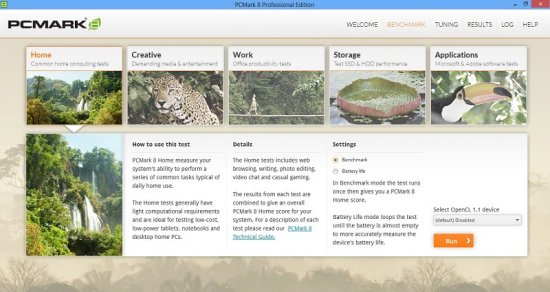
PCMark 8 FutureMark's latest version of their popular series of PC benchmarking tools. Improving on previous releases, PCMark 8 includes battery life measurement tools and new tests using popular applications from Adobe and Microsoft. Whether you are looking for long battery life, or maximum power, PCMark 8 helps you find the devices that offer the perfect combination of efficiency and performance for your needs.
Use the PCMark 8 Storage benchmark to test the performance of SSDs, HDDs, and hybrid drives with traces recorded from Adobe Creative Suite, Microsoft Office, and a selection of popular games. You can test the system drive or any other recognized storage device, including local external drives. Unlike synthetic storage tests, the PCMark 8 Storage benchmark highlights real-world performance differences between storage devices.
PCMark 8's Storage Performance Benchmark is an absolute beast of a test. The benchmark beats the hell out of your drive/array for well over an hour, resulting in a very thorough evaluation of a drives real-world performance.
OS Volume 75% full - Lightly Used

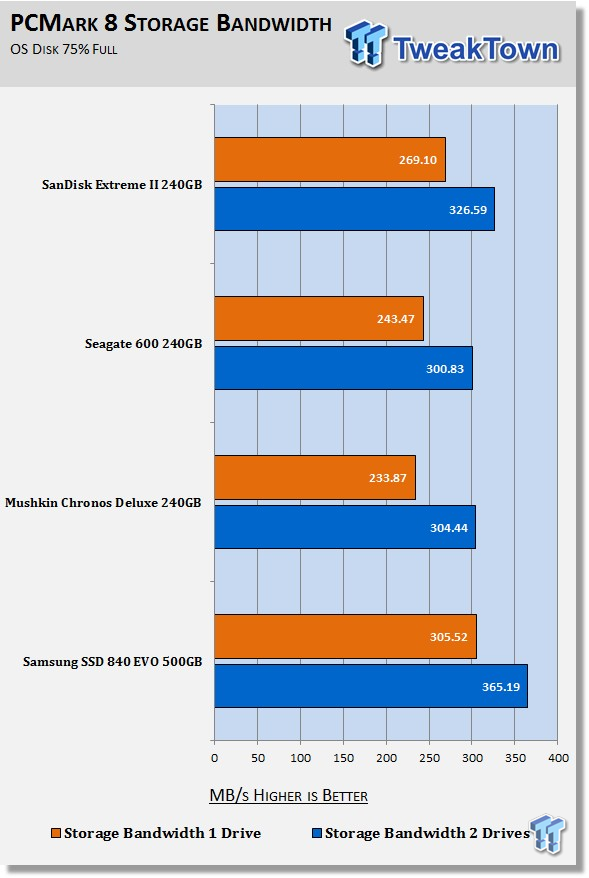
According to PCMark 8's storage bandwidth results, our Extreme II array has more storage bandwidth than our 600 series or Chronos arrays.
Secondary Volume Benchmarks - Blackmagicdesign's Disk Speed Test
Disk Speed Test
Version and / or Patch Used: 2.1.1
Product Homepage: http://www.blackmagicdesign.com
Disk Speed Test is an easy to use tool to quickly measure and certify your disk performance for working with high quality video! Simply click the start button, and Disk Speed Test will write test your disk using large blocks of data, and then display the result. Disk Speed Test will continue to test writes and reads from your disk so you can evaluate both performance and readability over time.
We rate a drive/array's video capability by the number of different categories that the device is capable of passing. The maximum number of tests that are possible to pass are 45 write tests and 45 read tests. We chart the number of tests a disk/array is capable of passing for a comparison of one drive/array verses another.


It's very hard for a single drive to be completely HD video capable. This is why serious video processing is done almost exclusively utilizing RAID arrays. Sequential incompressible performance is the name of the game when it comes to video processing. As expected, both two and three drive Extreme II arrays are completely HD video capable. SanDisk's Extreme II with its nCache Technology is ideally suited to video processing because of its low write amplification.
Secondary Volume Benchmarks - Disk Response Times
Iometer
Version and / or Patch Used: 1.1.0
Product Homepage: http://www.iometer.org
Download here: http://sourceforge.net/projects/iometer
Iometer is an I/O subsystem measurement and characterization tool for single and clustered systems. It was originally developed by the Intel Corporation and announced at the Intel Developers Forum (IDF) on February 17, 1998; since then it's become wide spread within the storage industry.
We use Iometer to measure disk response times. Disk response times are measured at an industry accepted standard of 4K QD1 for both write and read. Each test is run twice for thirty seconds consecutively, with a five second ramp-up before each test. The drive/array is partitioned and attached as a secondary device for this testing.
Write Response

Read Response

Average Disk Response
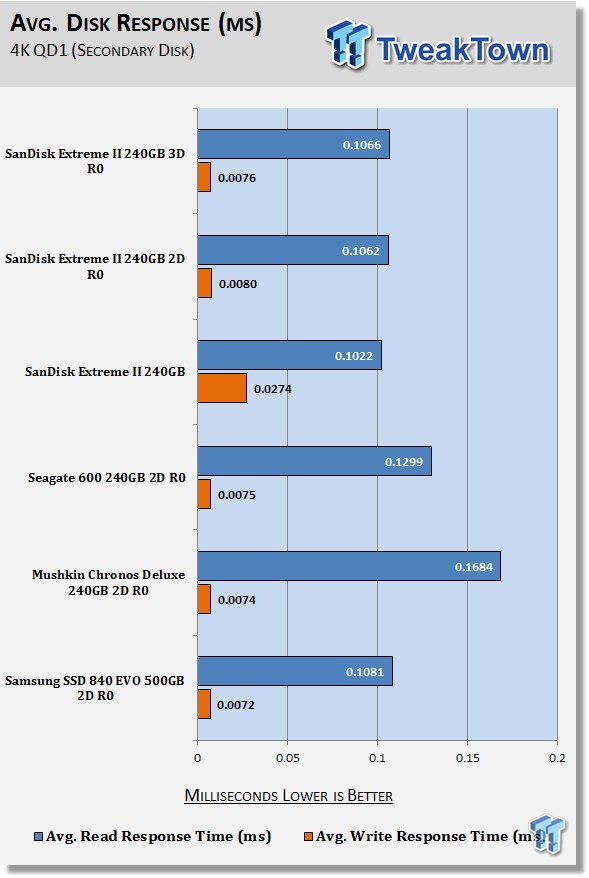
Write response times benefit most from RAID 0 because of write caching. There is a slight latency increase in read response times for an array vs. a single drive. Read response times are class leading and the main reason the Extreme II is considered a Hyper-Class SSD.
Secondary Volume Benchmarks - DiskBench
DiskBench - Directory Copy
Version and / or Patch Used: 2.6.2.0
Developer Homepage: Nodesoft
Product Homepage: DiskBench
Download here: http://www.nodesoft.com/diskbench/download
We use DiskBench to time a 28.6GB block (9,882 files in 1,247 folders) of mostly incompressible random data as it's transferred from our OS array to our test drive/array. We then read from a 6GB zip file that's part of our 28.6GB data block to determine the test drive/array's read transfer rate. The system is restarted prior to the read test to clear any cached data, insuring an accurate test result.
Write Transfer Rate
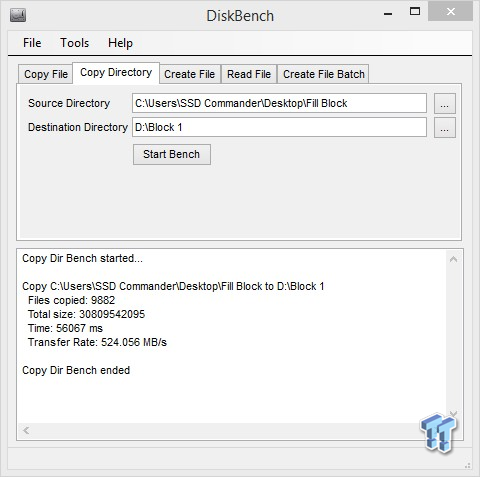
The Extreme II's real-world random write performance is outstanding.
Read Transfer Rate

Random read transfers for three drives in RAID 0 are pretty outstanding.
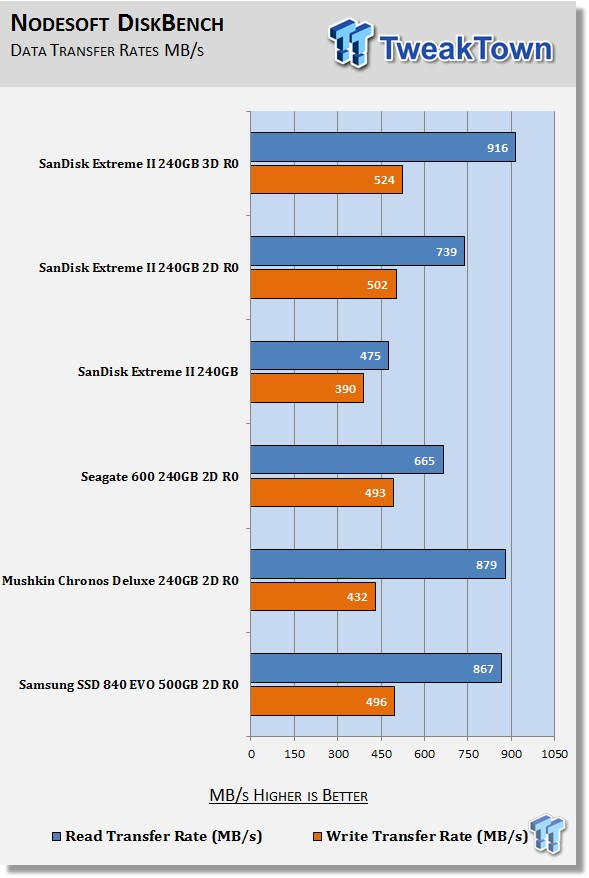
Looking at the chart, we see that a two drive Extreme II array has better write performance than all the other arrays on our chart. Compressed data is choking the Chronos array and the EVO array has run out of its "Turbo Write" emulated SLC layer capacity. When it comes to reading random data, the Chronos array and the EVO array have the advantage.
Final Thoughts

Solid state storage is the most important performance component found in a modern system today. Without it, you do not even have a performance system.
SanDisk's Extreme II takes all the latest technology and combines it together in one lightning fast package. The Extreme II is a Hyper-Class SSD that is quality built and comes with a class leading five year warranty and an extremely affordable price tag of only 75 cents per gigabyte. You can get a Samsung EVO for about the same price, but the EVO has a three year warranty, not a five year warranty.
The other Hyper-Class SSD's backed by a five year factory warranty (Samsung's 840 Pro and OCZ's Vector) either cost more (840 Pro) or, have an element of uncertainty when it comes to warranties (Vector).
If you are an enthusiast and are looking for a blazing fast solid state solution that's affordable and backed by an industry leading warranty, then take a close look at getting yourself a pair (or more) of Extreme II's. SanDisk's Extreme II is one of a very few SSD's that are fast enough to be classified "Hyper-Class," and that awesome performance gets magnified quite nicely when you run them in RAID 0.
RAIDing two or more drives together provides you with storage that takes performance to the next level and is something I recommend you try. Once you go RAID, there's no going back.


 United
States: Find other tech and computer products like this
over at
United
States: Find other tech and computer products like this
over at  United
Kingdom: Find other tech and computer products like this
over at
United
Kingdom: Find other tech and computer products like this
over at  Australia:
Find other tech and computer products like this over at
Australia:
Find other tech and computer products like this over at  Canada:
Find other tech and computer products like this over at
Canada:
Find other tech and computer products like this over at  Deutschland:
Finde andere Technik- und Computerprodukte wie dieses auf
Deutschland:
Finde andere Technik- und Computerprodukte wie dieses auf